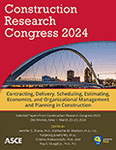Investigating Price Fluctuation Transmission among Construction Materials
Publication: Construction Research Congress 2024
ABSTRACT
Generally, fluctuation in one material’s price can cause a series of chain reactions in the supply chain system, known as price fluctuation transmission, as all materials are interconnected and interrelated. None of the previous studies have investigated price fluctuation transmission among all construction materials. This paper aims to fill this gap in knowledge. The authors collected producer price index (PPI) data for 16 construction materials, modeled the relationship between each pair of materials using vector autoregression technique, and validated the causality using Granger causality test. Network analysis was performed to identify the price fluctuation transmission capacity, susceptibility, and intermediatory capacity for each material. The results showed that the materials with the highest price transmission capacities include (1) “fabricated structural metal products”; (2) “construction sand, gravel, and crushed stone”; and (3) “plastic construction products.” Ultimately, it is concluded that significant changes in the price of these materials can be an indication of price escalations in the supply chain and other construction materials. This paper provides industry practitioners with an unprecedented framework that highlights materials that can act as early warning signs for overall price fluctuations in the construction industry.
Get full access to this article
View all available purchase options and get full access to this chapter.
REFERENCES
Fahimnia, B., Jabarzadeh, A., and Sarkis, J. (2018). Greening versus resilience: A supply chain design perspectrive. Transportaion Research, 129–148.
Flaaen, A., and Pierce, J. R. (2019). Disentangling the effects of the 2018-2019 tariffs on a globally connected US manufacturing sector.
Khalef, R., Ali, G. G., El-adaway, I. H., and Gad, G. M. (2022). Managing construction projects impacted by the COVID-19 pandemic: A contractual perspective. Construction Management and Economics, 40(4), 313–330.
Trost, S. M., and Oberlender, G. D. (2003). “Predicting accuracy of earlycost estimates using factor analysis and multivariate regression.”J. Constr. Eng. Manage., 129(2), 198–204.
Doğan, S. Z., Arditi, D., and Günaydın, H. M. (2006). “Determining attrib-ute weights in a CBR model for early cost prediction of structural systems.”J. Constr. Eng. Manage., 132(10), 1092–1098.
Diekmann, J. E. (1983). “Probabilistic estimating: Mathematics and appli-cations.”J. Constr. Eng. Manage., 109(3), 297–308.
Shiha, A., Dorra, E. M., and Nassar, K. (2020). Neural networks model for prediction of construction material prices in Egypt using macroeconomic indicators. Journal of Construction Engineering and Management, 146(3), 04020010.
Hwang, S. (2011). Time series models for forecasting construction costs using time series indexes. Journal of Construction Engineering and Management, 137(9), 656–662.
Kim, S., Abediniangerabi, B., and Shahandashti, M. (2021). Pipeline construction cost forecasting using multivariate time series methods. Journal of Pipeline Systems Engineering and Practice, 12(3), 04021026.
Acemoglu, D., Carvalho, V. M., Ozdaglar, A., and Tahbaz‐Salehi, A. (2012). The network origins of aggregate fluctuations. Econometrica, 80(5), 1977–2016.
Xu, S. W., Li, Z. M., Cui, L. G., Dong, X. X., Kong, F. T., and Li, G. Q. (2012). Price transmission in China’s swine industry with an application of MCM. Journal of Integrative Agriculture, 11(12), 2097–2106.
Sun, Q., Gao, X., Wen, S., Chen, Z., and Hao, X. (2018). The transmission of fluctuation among price indices based on Granger causality network. Physica A: Statistical Mechanics and its Applications, 506, 36–49.
Zheng, X., and Pan, Z. (2022). Responding to import surges: Price transmission from international to local soybean markets. International Review of Economics & Finance, 82, 584–597.
BLS (Bureau of Labor Statistics). (2023). “Producer Price Indexes”. Accessed April 02,2023 https://www.bls.gov/ppi/.
Baek, M., and Ashuri, B. (2019). Analysis of the variability of submitted unit price bids for asphalt line items in highway projects. Journal of Construction Engineering and Management, 145(4), 04019020.
Li, M., Baek, M., and Ashuri, B. (2021). Forecasting ratio of low bid to owner’s estimate for highway construction. Journal of Construction Engineering and Management, 147(1), 04020157.
AGC (Associated General Contractors). (2020). “Percentage Change in Producer Price Indexes (PPIs) and Employment Cost Indexes (ECIs) for Construction, 2013-2020.” Accessed March 15,2023. https://www.agc.org/sites/default/files/AGC_PPI_2020.pdf.
Shahandashti, S. M., and Ashuri, B. (2013). Forecasting engineering news-record construction cost index using multivariate time series models. Journal of Construction Engineering and Management, 139(9), 1237–1243.
Qiao, X., and Guo, H. (2014). Research on the effect of the exchange rate of RMB on housing prices based on the VAR Model. In ICCREM 2014: Smart Construction and Management in the Context of New Technology (pp. 1251–1259).
Faghih, S. A. M., and Kashani, H. (2018). Forecasting construction material prices using vector error correction model. Journal of construction engineering and management, 144(8), 04018075.
Assaad, R. H., and El-adaway, I. H. (2021). Stock prices of architectural, engineering, and construction firms as leading economic indicator: A computational deep-learning econometrics model to complement the architecture billings index. Journal of Architectural Engineering, 27(4), 04021043.
Granger, C. W. (1969). “Investigating causal relations by econometric mod-els and cross-spectral methods.”Econometrica37 (3): 424–438.https://doi.org/10.2307/1912791.
Wei, W. (2013). Vertical specialization and trade surplus in China.Amsterdam, Netherlands: Elsevier.
Lee, C. Y., Chong, H. Y., Liao, P. C., and Wang, X. (2018). Critical review of social network analysis applications in complex project management. Journal of management in engineering, 34(2), 04017061.
Hassan, R., Yosri, A., Ezzeldin, M., and El-Dakhakhni, W. (2022). Robustness Quantification of Transit Infrastructure under Systemic Risks: A Hybrid Network–Analytics Approach for Resilience Planning. Journal of transportation engineering, Part A: Systems, 148(10), 04022089.
Zhang, J., and Luo, Y. (2017). Degree centrality, betweenness centrality, and closeness centrality in social network. In 2017 2nd international conference on modelling, simulation and applied mathematics (MSAM2017) (pp. 300–303). Atlantis press.
Information & Authors
Information
Published In
History
Published online: Mar 18, 2024
Authors
Metrics & Citations
Metrics
Citations
Download citation
If you have the appropriate software installed, you can download article citation data to the citation manager of your choice. Simply select your manager software from the list below and click Download.
